[English] 日本語
 Yorodumi
Yorodumi- PDB-2ys5: Solution structure of the complex of the PTB domain of SNT-2 and ... -
+ Open data
Open data
- Basic information
Basic information
| Entry | Database: PDB / ID: 2ys5 | ||||||
|---|---|---|---|---|---|---|---|
| Title | Solution structure of the complex of the PTB domain of SNT-2 and 19-residue peptide (aa 1571-1589) of hALK | ||||||
 Components Components |
| ||||||
 Keywords Keywords | SIGNALING PROTEIN / Complex / SNT-2 / PTB domain / hALK / Structural Genomics / NPPSFA / National Project on Protein Structural and Functional Analyses / RIKEN Structural Genomics/Proteomics Initiative / RSGI | ||||||
| Function / homology |  Function and homology information Function and homology informationASP-3026-resistant ALK mutants / NVP-TAE684-resistant ALK mutants / alectinib-resistant ALK mutants / brigatinib-resistant ALK mutants / ceritinib-resistant ALK mutants / crizotinib-resistant ALK mutants / lorlatinib-resistant ALK mutants / MDK and PTN in ALK signaling / receptor signaling protein tyrosine kinase activator activity / regulation of dopamine receptor signaling pathway ...ASP-3026-resistant ALK mutants / NVP-TAE684-resistant ALK mutants / alectinib-resistant ALK mutants / brigatinib-resistant ALK mutants / ceritinib-resistant ALK mutants / crizotinib-resistant ALK mutants / lorlatinib-resistant ALK mutants / MDK and PTN in ALK signaling / receptor signaling protein tyrosine kinase activator activity / regulation of dopamine receptor signaling pathway / fibroblast growth factor receptor binding / response to environmental enrichment / ALK mutants bind TKIs / transmembrane receptor protein tyrosine kinase adaptor activity / swimming behavior / phosphorylation / RND1 GTPase cycle / regulation of neuron differentiation / positive regulation of dendrite development / RND2 GTPase cycle / peptidyl-tyrosine autophosphorylation / Signaling by ALK / adult behavior / response to stress / fibroblast growth factor receptor signaling pathway / neuron development / Activated NTRK2 signals through FRS2 and FRS3 / negative regulation of lipid catabolic process / energy homeostasis / FRS-mediated FGFR3 signaling / FRS-mediated FGFR2 signaling / FRS-mediated FGFR4 signaling / FRS-mediated FGFR1 signaling / transmembrane receptor protein tyrosine kinase activity / cell surface receptor protein tyrosine kinase signaling pathway / hippocampus development / : / receptor protein-tyrosine kinase / Signaling by ALK fusions and activated point mutants / heparin binding / regulation of cell population proliferation / protein autophosphorylation / RAF/MAP kinase cascade / protein tyrosine kinase activity / regulation of apoptotic process / receptor complex / signal transduction / protein-containing complex / extracellular exosome / ATP binding / identical protein binding / plasma membrane / cytoplasm Similarity search - Function | ||||||
| Biological species |  Homo sapiens (human) Homo sapiens (human) | ||||||
| Method | SOLUTION NMR / torsion angle dynamics | ||||||
 Authors Authors | Li, H. / Koshiba, S. / Inoue, M. / Kigawa, T. / Yokoyama, S. / RIKEN Structural Genomics/Proteomics Initiative (RSGI) | ||||||
 Citation Citation |  Journal: J.Struct.Funct.Genom. / Year: 2010 Journal: J.Struct.Funct.Genom. / Year: 2010Title: Structural basis for the recognition of nucleophosmin-anaplastic lymphoma kinase oncoprotein by the phosphotyrosine binding domain of Suc1-associated neurotrophic factor-induced tyrosine-phosphorylated target-2 Authors: Koshiba, S. / Li, H. / Motoda, Y. / Tomizawa, T. / Kasai, T. / Tochio, N. / Yabuki, T. / Harada, T. / Watanabe, S. / Tanaka, A. / Shirouzu, M. / Kigawa, T. / Yamamoto, T. / Yokoyama, S. | ||||||
| History |
| ||||||
| Remark 650 | HELIX Determination method: Author determined | ||||||
| Remark 700 | SHEET Determination method: Author determined |
- Structure visualization
Structure visualization
| Structure viewer | Molecule:  Molmil Molmil Jmol/JSmol Jmol/JSmol |
|---|
- Downloads & links
Downloads & links
- Download
Download
| PDBx/mmCIF format |  2ys5.cif.gz 2ys5.cif.gz | 998.6 KB | Display |  PDBx/mmCIF format PDBx/mmCIF format |
|---|---|---|---|---|
| PDB format |  pdb2ys5.ent.gz pdb2ys5.ent.gz | 841.1 KB | Display |  PDB format PDB format |
| PDBx/mmJSON format |  2ys5.json.gz 2ys5.json.gz | Tree view |  PDBx/mmJSON format PDBx/mmJSON format | |
| Others |  Other downloads Other downloads |
-Validation report
| Summary document |  2ys5_validation.pdf.gz 2ys5_validation.pdf.gz | 356.6 KB | Display |  wwPDB validaton report wwPDB validaton report |
|---|---|---|---|---|
| Full document |  2ys5_full_validation.pdf.gz 2ys5_full_validation.pdf.gz | 625.7 KB | Display | |
| Data in XML |  2ys5_validation.xml.gz 2ys5_validation.xml.gz | 70.4 KB | Display | |
| Data in CIF |  2ys5_validation.cif.gz 2ys5_validation.cif.gz | 85.9 KB | Display | |
| Arichive directory |  https://data.pdbj.org/pub/pdb/validation_reports/ys/2ys5 https://data.pdbj.org/pub/pdb/validation_reports/ys/2ys5 ftp://data.pdbj.org/pub/pdb/validation_reports/ys/2ys5 ftp://data.pdbj.org/pub/pdb/validation_reports/ys/2ys5 | HTTPS FTP |
-Related structure data
| Related structure data |  2kupC  2kuqC 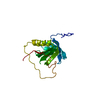 2yt2C C: citing same article ( |
|---|---|
| Similar structure data | |
| Other databases |
- Links
Links
- Assembly
Assembly
| Deposited unit | 
| |||||||||
|---|---|---|---|---|---|---|---|---|---|---|
| 1 |
| |||||||||
| NMR ensembles |
|
- Components
Components
| #1: Protein | Mass: 16332.278 Da / Num. of mol.: 1 / Fragment: PTB domain Source method: isolated from a genetically manipulated source Source: (gene. exp.)  Homo sapiens (human) / Description: cell-free protein synthesis / Gene: FRS3 / Plasmid: P060320-18 / References: UniProt: O43559 Homo sapiens (human) / Description: cell-free protein synthesis / Gene: FRS3 / Plasmid: P060320-18 / References: UniProt: O43559 |
|---|---|
| #2: Protein/peptide | Mass: 2343.644 Da / Num. of mol.: 1 / Fragment: residues in database 1571-1589 / Source method: obtained synthetically Details: The peptide was chemically synthesized. The sequence is taken from Homo sapiens. References: UniProt: Q9UM73, receptor protein-tyrosine kinase |
-Experimental details
-Experiment
| Experiment | Method: SOLUTION NMR | ||||||||||||||||||||||||
|---|---|---|---|---|---|---|---|---|---|---|---|---|---|---|---|---|---|---|---|---|---|---|---|---|---|
| NMR experiment |
|
- Sample preparation
Sample preparation
| Details | Contents: 0.37mM SNT-2 PTB domain U-15N, 13C in complex with hALK peptide (1:1); 20mM d-Tris-HCl; 100mM NaCl; 1mM d-DTT; 0.02% NaN3; 90% H2O, 10% D2O Solvent system: 90% H2O/10% D2O |
|---|---|
| Sample conditions | Ionic strength: 120mM / pH: 7 / Pressure: ambient / Temperature: 298 K |
-NMR measurement
| NMR spectrometer | Type: Bruker AVANCE / Manufacturer: Bruker / Model: AVANCE / Field strength: 800 MHz |
|---|
- Processing
Processing
| NMR software |
| ||||||||||||||||||||||||||||
|---|---|---|---|---|---|---|---|---|---|---|---|---|---|---|---|---|---|---|---|---|---|---|---|---|---|---|---|---|---|
| Refinement | Method: torsion angle dynamics / Software ordinal: 1 | ||||||||||||||||||||||||||||
| NMR representative | Selection criteria: lowest energy | ||||||||||||||||||||||||||||
| NMR ensemble | Conformer selection criteria: structures with the least restraint violations, target function Conformers calculated total number: 100 / Conformers submitted total number: 20 |
 Movie
Movie Controller
Controller



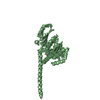
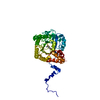
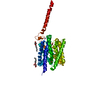

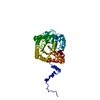
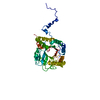
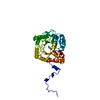
 PDBj
PDBj

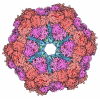





 NMRPipe
NMRPipe